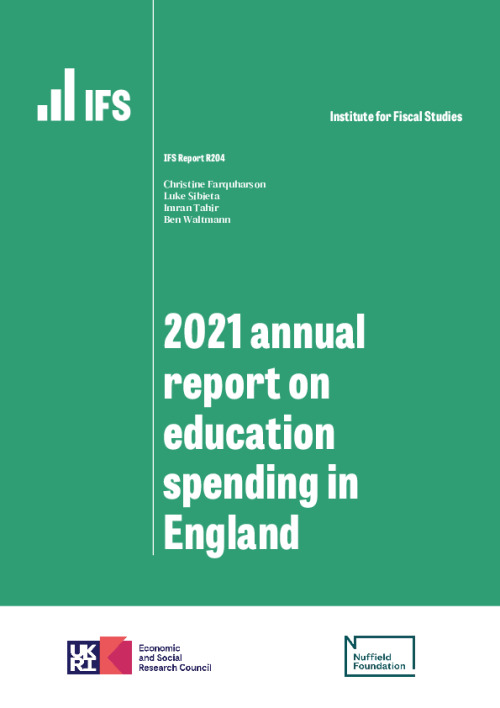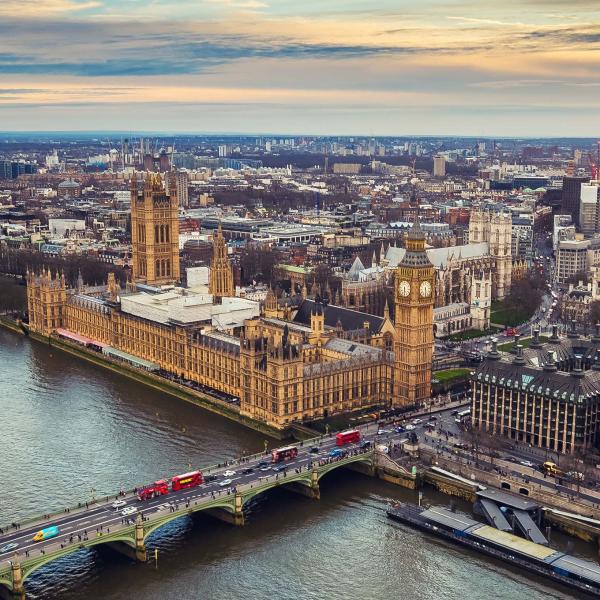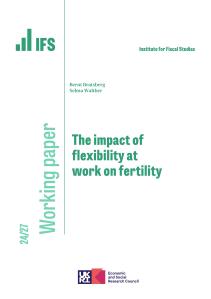Education spending is the second-largest element of public service spending in the UK behind health, representing about £99 billion in 2020–21 in today’s prices or about 4.5% of national income. To make efficient and equitable policy choices, it is crucial to have a clear, consistent picture of the level of spending at each phase of education, how this has changed over time, how it is likely to evolve going forwards and what factors have driven these changes. This provides policymakers and the public with a sense of current resource priorities and future challenges. These issues are also a vital component of the education policy debate, particularly given empirical evidence showing how investments at different stages of the life cycle combine to drive long-run outcomes (Cunha, Heckman and Schennach, 2010; Johnson and Jackson, 2019).
Total spending
- Before the pandemic, total spending on education in the UK stood at £104 billion or 4.4% of national income in 2019–20 (including the likely cost of issuing student loans). This is 8% lower than in 2010–11, when it represented 5.6% of national income.
- Before the financial crisis, education spending represented just under 5% of national income. If it had remained at this level, it would have been £16 billion higher in 2019–20.
- Whilst education spending has mostly fluctuated between 4% and 5% of national income over the last 30 years, health spending has seen substantial increases, rising from 4% of national income in the early 1990s to over 7% just before the pandemic. This reflects the costs of an ageing society, but also spending and policy choices by successive governments.
- In the latest year (2020–21), there was a 3% real-terms increase in education spending, which partly reflects temporary extra levels of support during the pandemic.
Early years
- Government spending on funded early education and childcare places stood at £3.8 billion in 2020–21 (in today’s prices). For 3- and 4-year-olds, this is equivalent to £4,200 per child accessing a place. This is partly inflated by reduced numbers of children attending early years settings during the pandemic, with spending around £3,900 per child the year before.
- Over the past decade, hourly free entitlement spending has tended to follow a ratchet pattern: meaningful boosts in 2012 and 2017 were followed by years of cash-terms freezes, eroding spending power in real terms.
- In 2020–21, extra funding led spending per hour to rise in real terms from £5.44 to £5.71 (2021–22 prices), about the same level as two years earlier (but less than its high point of £5.89 in 2017).
- The Spending Review included about an extra £170 million per year for the early years entitlement. The government has recently announced that, in 2022-23, it will use some of this money to increase the core funding rate for the 3- and 4-year-old offer by 17p an hour. With a rising minimum wage and new taxes like the health and social care levy, this relatively small increase will almost certainly not be enough to compensate for rising costs.
Schools
- School spending per pupil in England fell by 9% in real terms between 2009–10 and 2019–20. This represents the largest cut in over 40 years, but it came on the back of a significant increase in spending per pupil of over 60% during the 2000s.
- The 2021 Spending Review included an extra £4.4 billion for the schools budget in 2024–25 as compared with previous plans. When combined with existing plans, we project that spending per pupil in 2024 will be at about the same level as in 2010. Whilst this will reverse past cuts, it will mean 15 years with no overall growth in spending. This squeeze on school resources is effectively without precedent in post-war UK history.
- Secondary school spending per pupil in England (£6,600) was about 14% higher than in primary schools (£5,800) in 2020–21. This is down from a secondary/primary funding difference of about 30% in the 2000s and over 50% during the early 1990s. Whilst empirical evidence shows high benefits to spending at younger ages, it is not clear that evidence supports such a dramatic shift.
- Deprived schools have seen larger cuts over the last decade. The most deprived secondary schools saw a 14% real-terms fall in spending per pupil between 2009–10 and 2019–20, compared with a 9% drop for the least deprived schools. The National Funding Formula has continued this pattern by providing bigger real-terms increases for the least deprived schools (8–9%) than for the most deprived ones (5%) between 2017–18 and 2022–23. The Pupil Premium has also failed to keep pace with inflation since 2015. These patterns run counter to the government’s goal of levelling up poorer areas.
Further education and sixth forms
- Further education colleges and sixth forms have seen the largest falls in per-pupil funding of any sector of the education system since 2010–11. Funding per student aged 16–18 in further education and sixth-form colleges fell by 14% in real terms between 2010–11 and 2019–20, while funding per student in school sixth forms fell by 28%.
- The government allocated an extra £700 million to colleges and sixth forms in 2020 and 2021. However, most of this has been eroded by rapid growth in student numbers. Looking forwards, this growth in student numbers represents a continuing major challenge for colleges and sixth forms, with further growth of 10% expected between 2021 and 2024.
- As a result of additional funding in the 2021 Spending Review, total spending per student in 16–18 education is set to rise by 6% between 2021–22 and 2024–25.
- Yet even with this additional funding, college spending per pupil in 2024–25 will still be around 10% below 2010–11 levels, while school sixth-form spending per pupil will be 23% below 2010–11 levels. Therefore, the additional funding for 16–18 education will only serve to partially reverse the cuts of the previous decade.
Higher education
- Following the major reforms of 2012 and increase in tuition fees to £9,000, fees have mostly been held constant in cash terms, eroding their real value over time. As a result, up-front higher education spending per undergraduate student in 2020–21 was about 9% lower in real terms than it was in 2012–13.
- As with further education, a major challenge for the higher education sector is the expected growth in student numbers, which are expected to rise by 13% between the 2019–20 and the 2025–26 entry cohorts.
- There was surprisingly little mention of higher education funding in the recent Spending Review, though a number of potential changes have been rumoured, such as reductions in fees to £8,500 and in the threshold at which graduates begin to repay their loans to £22,000.
- A lower tuition fee cap at £8,500 would only benefit the highest earners. The impact on the government finances would depend on whether teaching grants were increased at the same time to compensate universities for the loss in fee income. If so, this would be a good opportunity to rebalance teaching grants towards higher-cost subjects.
A lower repayment threshold of £22,000 would essentially be a tax rise for the nearly 80% of graduates expected not to clear their loans, raising around £2 billion a year. Graduates with middling earnings would need to pay around £500 more towards their loans per year. An extension of the loan repayment period to 40 years would raise roughly the same amount but only affect graduates later in life.
Visit our dedicated microsite:https://ifs.org.uk/education-spending













